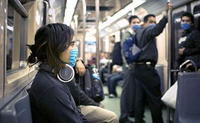-
A world free of foot-and-mouth disease within sight
The Departments of Homeland Security and Agriculture have developed a novel vaccine for one of the seven strains of the dreaded foot-and-mouth disease (FMD), paving the way for the development of the others; FMD is one of the most economically devastating diseases in the world for those who raise cows, sheep, pigs, goats, deer, and other cloven-hoofed animals is foot-and-mouth disease
-
-
USDA gives GenVec conditional approval for FMD vaccine for cattle
The USDA has issued a conditional license for GenVec’s foot-and-mouth disease (FMD) vaccine for use in cattle; GenVec’s cell line is capable of producing antigens without the use of the highly contagious FMD virus; because the vaccine is produced without using live or killed virus materials, it can be produced cost effectively in the United States and around the world
-
-
A record: half of U.S. land area is in various stages of drought

Analysis of the latest drought monitor data revealed that 46.84 percent of the U.S. land area is in various stages of drought, up from 42.8 percent a week ago; previous records were 45.87 percent in drought on 26 August 2003, and 45.64 percent on 10 September 2002; looking only at the forty-eight contiguous states, 55.96 percent of the country’s land area is in moderate drought or worse — also the highest percentage on record
-
-
Students and scientists gather in Singapore to discuss water problem
International university students and water experts have converged at Singapore’s Nanyang Technological University (NTU) to foster an intellectual and research community on a scarce natural resource — water
-
-
U.K. potential food crisis
Many climate experts believe a slight rise in U.K. temperatures would be beneficial for the farming industry as yields could increase; as temperatures continue to rise, however, farmers would need to use more and more fertilizer on their crops and some livestock would not be as productive; consumers could thus face reduced food choices
-
-
Even a limited India-Pakistan nuclear war would substantially reduce global crop yields

Worries about nuclear winter have faded since the end of the cold war, but existing stockpiles of nuclear weapons still hold the potential for devastating global impacts; researchers have found that the climate effects of a hypothetical nuclear war between India and Pakistan would greatly reduce yields of staple crops, even in distant countries
-
-
Measuring the uncertainties of pandemic influenza

Researchers have highlighted three factors that could ultimately determine whether an outbreak of influenza becomes a serious epidemic that threatens national health; the research suggests that the numbers in current response plans could be out by a factor of two or more depending on the characteristics of the particular pandemic influenza
-
-
Viewing terrorist attacks on TV increases pain intensity

A new study finds that exposure to media coverage of terrorist missile attacks increases pain levels in people already suffering from chronic pain
-
-
Developing a new test for safer milk
Brucellosis is the most common animal-to-human infection worldwide, with more than 500,000 new cases reported each year; it rarely causes death, but it can result in prolonged health problems; researchers received a 3-year grant of $500,000 from the U.S. Department of Agriculture to develop a new technology that can rapidly test milk and other dairy products for harmful pathogens
-
-
New sensors detect contaminants in water
Many organic contaminants in the air and in drinking water need to be detected at very low-level concentrations; researchers have investigated the use of graphene oxide films in which the semiconductor titanium dioxide (TiO2) and metal nanoparticles are deposited on opposite sides of the graphene surface
-
-
Tasers do not cause cardiac complications: study

Tasers are commonly used by law enforcement personnel worldwide as an intermediate-force option to subdue and apprehend potentially dangerous or combative suspects; tasers function by delivering a series of very brief high-voltage, low-current electric pulses that result in pain, muscle contraction and inhibition of voluntary movement; taser shots to the chest are no more dangerous than those delivered to other body locations, according to a new study
-
-
USDA releases requests for applications for the AFRI food safety challenge
The Department of Agriculture’s National Institute of Food and Agriculture says that this year’s grants under the Agriculture and Food Research Initiative will focus on promoting and enhancing the scientific discipline of food safety, with an overall aim of protecting consumers from microbial, chemical, and physical hazards that may occur during all stages of the food chain, from production to consumption
-
-
Loo turns poo into power
Researchers have invented a new toilet system that will turn human waste into electricity and fertilizers and also reduce the amount of water needed for flushing by up to 90 percent compared to current toilet systems
-
-
Paper-printed rapid disease detection test
Complex laboratory investigations do produce reliable results, but they are not useful for point-of-care diagnostics; researchers have come up with a clever idea: biosensors based on paper; the test is printed on one side of a chromatography paper, the paper is folded up origami-style, laminated, and the test is ready; test evaluation requires only a voltmeter
-
-
Do nano-pesticides hold promise or pose threat to greener agriculture?
Nanotechnology has developed significantly in the past decade and was able to create many new materials with a vast range of potential applications; the risk that nano-particles may pose to human and environment health, however, is not yet fully understood; a precautionary principle suggests keeping environmental release of nano-particles minimal until their fate and toxicity is better understood
-
More headlines
The long view
We Ran the C.D.C.: Kennedy Is Endangering Every American’s Health
Nine former leaders of the Centers for Disease Control and Prevention (CDC), who served as directors or acting directors under Republican and Democratic administrations, serving under presidents from Jimmy Carter to Donald Trrump, argue that HHS Secretary Roert F. Kennedy Jr. poses a clear and present danger to the health of Americans. He has placed anti-vaxxers and conspiracy theorists at top HHS positions, and he appears to be guided by a hostility to science and a belief in bizarre, unscientific approaches to public health.
